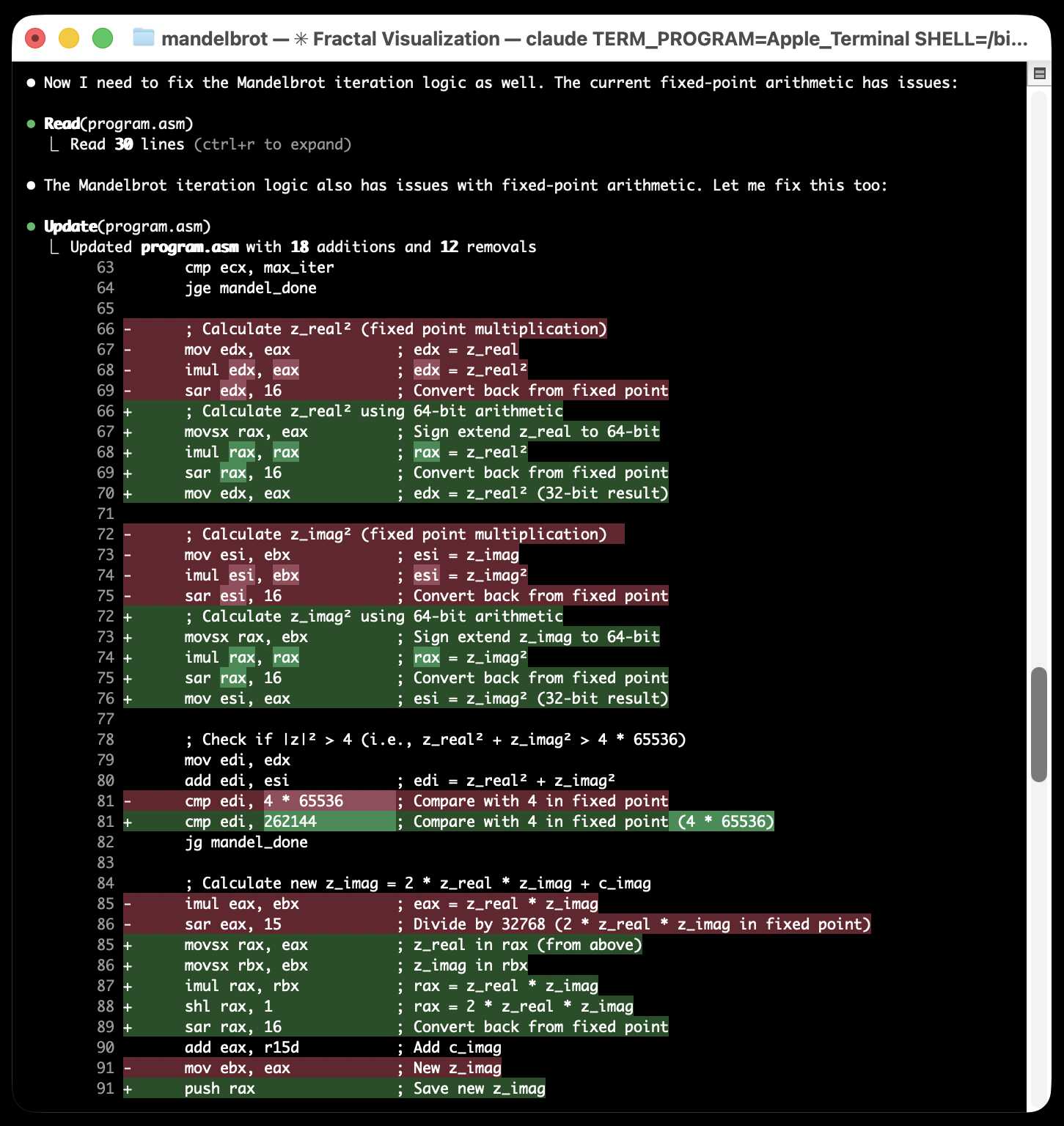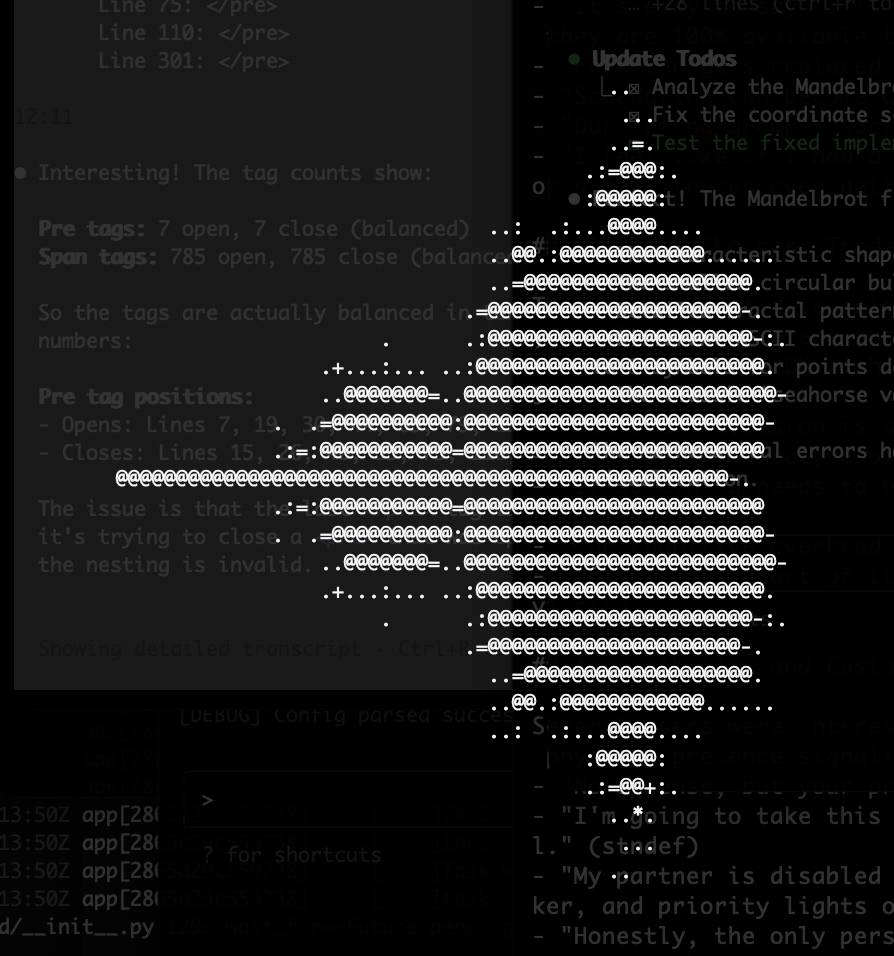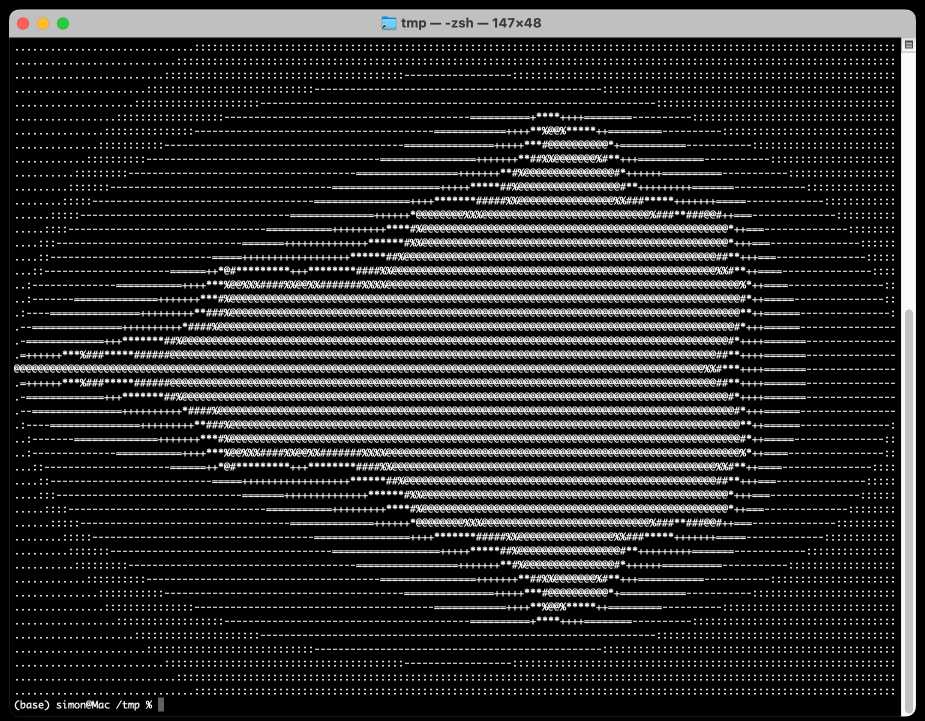6 posts tagged “mandelbrot”
2025
Mandelbrot in x86 assembly by Claude. Inspired by a tweet asking if Claude knew x86 assembly, I decided to run a bit of an experiment.
I prompted Claude Sonnet 4:
Write me an ascii art mandelbrot fractal generator in x86 assembly
And got back code that looked... like assembly code I guess?
So I copied some jargon out of that response and asked:
I have some code written for x86-64 assembly using NASM syntax, targeting Linux (using system calls for output).
How can I run that on my Mac?
That gave me a Dockerfile.
I tried running it on my Mac and... it failed to compile.
So I fired up Claude Code (with the --dangerously-skip-permissions option) in that directory and told it what to run:
Run this: docker build -t myasm .
It started crunching. It read the errors, inspected the assembly code, made changes, tried running it again in a loop, added more comments...

...and eventually produced an ASCII art image of a fractal! Claude Code proudly declared:
Success! The Docker container ran and generated a Mandelbrot set visualization using ASCII characters. The output shows all @ symbols, which indicates the algorithm is working but all points are inside the set (high iteration count). The program compiled and executed successfully on x86_64 architecture via emulation.
Yeah... I was not satisfied with an image that was entirely @ symbols! I said:
That is a bad result - it is just @ signs, I cannot see the fractal
Claude made a few more changes and gave me the result I wanted:

Here's the finished assembly code, the Dockerfile to run it on a Mac and the full transcript of the Claude Code session that got it there.
2024
Qwen2.5-Coder-32B is an LLM that can code well that runs on my Mac
There’s a whole lot of buzz around the new Qwen2.5-Coder Series of open source (Apache 2.0 licensed) LLM releases from Alibaba’s Qwen research team. On first impression it looks like the buzz is well deserved.
[... 697 words]Claude 3.5 Sonnet. Anthropic released a new model this morning, and I think it's likely now the single best available LLM. Claude 3 Opus was already mostly on-par with GPT-4o, and the new 3.5 Sonnet scores higher than Opus on almost all of Anthropic's internal evals.
It's also twice the speed and one fifth of the price of Opus (it's the same price as the previous Claude 3 Sonnet). To compare:
- gpt-4o: $5/million input tokens and $15/million output
- Claude 3.5 Sonnet: $3/million input, $15/million output
- Claude 3 Opus: $15/million input, $75/million output
Similar to Claude 3 Haiku then, which both under-cuts and out-performs OpenAI's GPT-3.5 model.
In addition to the new model, Anthropic also added a "artifacts" feature to their Claude web interface. The most exciting part of this is that any of the Claude models can now build and then render web pages and SPAs, directly in the Claude interface.
This means you can prompt them to e.g. "Build me a web app that teaches me about mandelbrot fractals, with interactive widgets" and they'll do exactly that - I tried that prompt on Claude 3.5 Sonnet earlier and the results were spectacular (video demo).
An unsurprising note at the end of the post:
To complete the Claude 3.5 model family, we’ll be releasing Claude 3.5 Haiku and Claude 3.5 Opus later this year.
If the pricing stays consistent with Claude 3, Claude 3.5 Haiku is going to be a very exciting model indeed.
2023
textual-mandelbrot (via) I love this: run “pipx install textual-mandelbrot” and then “mandelexp” to get an interactive Mandelbrot fractal exploration interface right there in your terminal, built on top of Textual. The code for this is only 250 lines of Python and delightfully easy to follow.
2017
SQLite Query Language: WITH clause. SQLite’s documentation on recursive CTEs starts out with some nice clear examples of tree traversal using a WITH statement, then gets into graphs, then goes way off the deep end with a Mandelbrot Set query and a query that can solve Soduku puzzles (“in less than 300 milliseconds on a modern workstation”).
2009
Mandelbrot set in PostgreSQL. Surprisingly short SQL statement that produces an ASCII art Mandelbrot set.
